Bhutan through Kaleidoscope Festivals
|
Read. Imagine. Travel.
Happiness is when what you think, what you say, and what you do are in harmony.
With this in mind here we are, with another edition of ‘TravNama’ that focuses on the land of Gross National Happiness – Bhutan, The Last Shangri La!
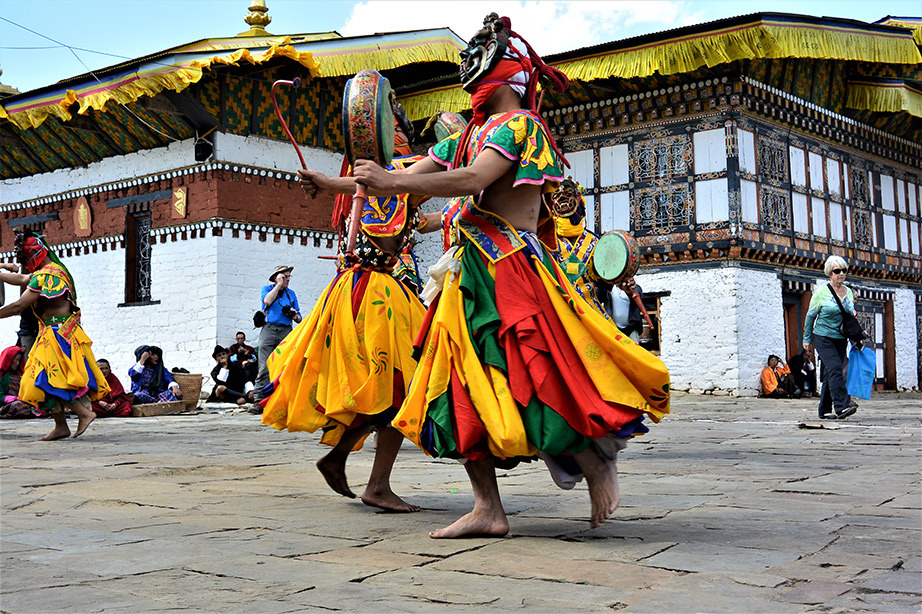
Bhutan, a small and predominantly Buddhist nation, tucked between China and India, is lanced by deep ravines and coated with thick woods. In 1972, Bhutan identified Gross National Happiness as more important than the Gross National Product and is the only country to do so. Enjoy Bhutan with a short video.
The Land of Thunder Dragon has a plethora of experiences to offer. The best way to add something new to your travel to Bhutan is to attend a Tshechu or a Bhutanese festival, each of which has a different meaning and a story behind. It is astonishing to see how the locals are eager to share their cultures and traditions through their dances, music and prayers, especially during the festivals. Most of these colourful festivals are dedicated to Guru Rimpoche (also called Guru Padmasambhava) – the saint who introduced Bhutan to Buddhism in the early 8th century. Imagine yourself lost in the rhythmic music and masked dances amidst the Himalayas and the monasteries of Bhutan. Engaging performances, rare display of Thangkas or ancient scrolls, and the elusive masked dances of these festivals will leave you mesmerised.
Take a plunge into the world of fluttering prayer flags in the Himalayas, majestic Buddha statues, and vibrant masked dances. We have handpicked some of the best festivals in Bhutan:
Punakha Drubchen, Punakha
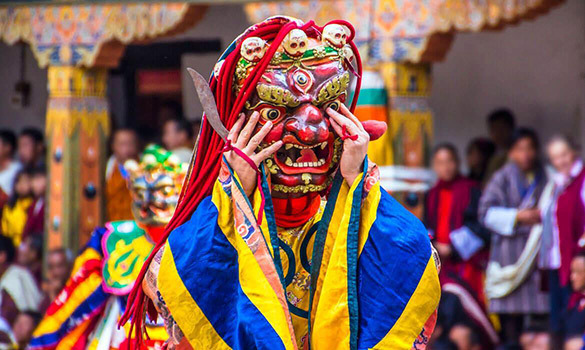 Puna Drubchen is an annual festival started by Zhabdrung to celebrate the victory of the Bhutanese kingdom over the Tibetans. It is followed by the more famed Punakha Tsechu, introduced in 2005, keeping in line with Bhutan's Dzong and monastic traditions. The annual Drubchen or Dromche of Punakha is quite unique because of its dramatic recreation of a 17th-century battle scene. It is a beautiful narration of Tibetan invasion of Bhutan to seize the Ranjung Kharsapani, a self-created image of Chenrizing, Bhutan's most precious relic. The legends say that Zhabdrung planned an extravagant ceremony in which he allegedly pretended to throw the Ranjung Kharsapani into the Mochu River. When the Tibetan army saw the act, they got very disappointed and withdrew from the kingdom. During the festival, a procession of monks led by the head Abbott proceeds to the river, where he throws a handful of oranges symbolizing the relic.
Puna Drubchen is an annual festival started by Zhabdrung to celebrate the victory of the Bhutanese kingdom over the Tibetans. It is followed by the more famed Punakha Tsechu, introduced in 2005, keeping in line with Bhutan's Dzong and monastic traditions. The annual Drubchen or Dromche of Punakha is quite unique because of its dramatic recreation of a 17th-century battle scene. It is a beautiful narration of Tibetan invasion of Bhutan to seize the Ranjung Kharsapani, a self-created image of Chenrizing, Bhutan's most precious relic. The legends say that Zhabdrung planned an extravagant ceremony in which he allegedly pretended to throw the Ranjung Kharsapani into the Mochu River. When the Tibetan army saw the act, they got very disappointed and withdrew from the kingdom. During the festival, a procession of monks led by the head Abbott proceeds to the river, where he throws a handful of oranges symbolizing the relic.
During the festival, the 'pazaps' or local militiamen, dressed in colorful battle gear, ride the horse and showcase a battle scene. At the end of the festival, there is a display of giant Thangka with images of Zhabdrung Nawang Namgyal.
This colorful festival's main attraction is the re-enactment of the great battle between Tibetans and the Bhutanese. This festival is a perfect example of witnessing glorious Bhutanese history.
Paro Tshechu, Paro
 One of the most renowned and famous festivals of Bhutan is the Paro Tshechu, which is a Buddhist Festival. The festival holds great religious significance and is celebrated to remember Bhutan's patron saint Guru Padmasambhava’s birth anniversary. It was he who introduced Tantric Buddhism in Bhutan. The Paro Tshechu is held mainly in the huge and magnificent courtyards of the Dzong and comprises of some of the most colorful masked dances along with the traditional folk songs. What adds charm to this already vibrant festival is the colorfully dressed Bhutanese people who come here to rejoice in celebration. As per the Bhutanese calendar, which is a variant of the lunisolar Tibetan calendar, the Paro Festival falls during the Spring every year.
One of the most renowned and famous festivals of Bhutan is the Paro Tshechu, which is a Buddhist Festival. The festival holds great religious significance and is celebrated to remember Bhutan's patron saint Guru Padmasambhava’s birth anniversary. It was he who introduced Tantric Buddhism in Bhutan. The Paro Tshechu is held mainly in the huge and magnificent courtyards of the Dzong and comprises of some of the most colorful masked dances along with the traditional folk songs. What adds charm to this already vibrant festival is the colorfully dressed Bhutanese people who come here to rejoice in celebration. As per the Bhutanese calendar, which is a variant of the lunisolar Tibetan calendar, the Paro Festival falls during the Spring every year.
It is also considered to be the most beautiful time to visit Bhutan. The bright and sunny mornings give you a clear view of the snow-capped Himalayan Mountains during the late mornings and afternoons. The evenings and early mornings are generally pleasant but also a bit cold.
The main attraction of Paro Tshechu is the Shingje Yabyum, which is the dance of Durdag, the lord of death, the dance of the lords of the cremation grounds, the dance of the drums from Drametse, and the dance of the black hats. Get a glimpse of Paro Festival.
Thimphu Tshechu, Thimphu
 Thimphu Tshechu is one of the biggest and most famous festivals in Bhutan. It is said that Tenzing Rabgye, the fourth Temporal Ruler established this festival in 1687, which was the 8th month of the Bhutanese calendar commemorating the birth of the Guru Rimpoche. It is organized in the courtyard of the Tashi Chhodzong, making it one of the most impressive Tshechus in the western region of Bhutan. The Tshechu is witnessed by thousands of people, the locals, and the tourists equally.
Thimphu Tshechu is one of the biggest and most famous festivals in Bhutan. It is said that Tenzing Rabgye, the fourth Temporal Ruler established this festival in 1687, which was the 8th month of the Bhutanese calendar commemorating the birth of the Guru Rimpoche. It is organized in the courtyard of the Tashi Chhodzong, making it one of the most impressive Tshechus in the western region of Bhutan. The Tshechu is witnessed by thousands of people, the locals, and the tourists equally.
Many local Bhutanese people travel from neighboring districts to attend the festivities and take part in the rejoicing. The Tshechu is led by prayers done on days and nights along with the rituals to invoke the gods. The Thimphu Tsechu is more like a religious festival, and as per a belief, it is said that if you attend this festival, it will help you gain merits with the Gods. It is also an annual social gathering where the people gather to rejoice in continued happiness, dressed in traditional finery attires.
Many learned lamas established this tradition of dances during the Thimphu Tschehu centuries ago. During the celebration, the deities of the Tantric teaching are invoked with the help of these dances.
Note: From the years of its establishment in 1687, Thimphu Tshechu was performed inside Trashichhoedzong courtyard until 2007. However, because of the steady increase in attendees, the inner courtyard became too congested to properly perform the rites. Therefore, to accommodate a growing number of viewers, a new Tshechu stadium was constructed and named Tendrel Thang, meaning ‘Auspicious Ground’
|
Jambay Lhakhang Drup, Bumthang
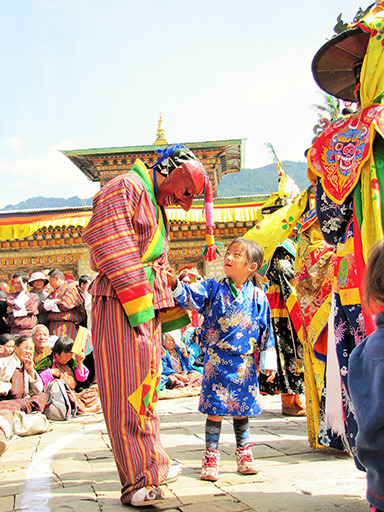 A must-see religious and cultural festival in Bumthang town, this festival is an exhibition of Bhutan's rich culture and heritage. This beautiful festival is celebrated for two reasons – one was the celebration of the deeds of Guru Rimpoche.
A must-see religious and cultural festival in Bumthang town, this festival is an exhibition of Bhutan's rich culture and heritage. This beautiful festival is celebrated for two reasons – one was the celebration of the deeds of Guru Rimpoche.
The second one was celebrating the commemoration of the Jambay Lhakhang temple's establishment in the 7th century. The festival is marked by several dance rituals like the naked dance and a dance under the fire, which is the most famous dance. Like many other religious festivals celebrated widely in Bhutan, Jambay Lhakhang Drup is also celebrated to thank the Gods for bestowing prosperity and happiness on the people living in the last Shangri La.
Another festival you can visit coinciding with Jambay Lhakhang Drup is the Prakhar Festival. It is a unique village festival celebrated every year in honor of Lama Thukse Dawa, son of the Treasure Discoverer, Pema Lingpa, who lived in Bumthang Valley in the 15th century.
Black Necked Crane Festival, Gangtey
 Located on a forest-clad hill commanding the Phobjikha Valley, Gangtey Goemba is one of the oldest and most comprehensive Nyingmapa monasteries in Bhutan.
Located on a forest-clad hill commanding the Phobjikha Valley, Gangtey Goemba is one of the oldest and most comprehensive Nyingmapa monasteries in Bhutan.
Every November, local Bhutanese farmers, and monks visit this monastery's courtyard to celebrate the arrival of their beloved visitors': The black-necked cranes. The Black Necked Carnes are among the rarest cranes globally and several hundred of these beautiful birds migrate here every year.
Started in 1998, this beautiful festival usually draws a huge number of travelers to this otherwise remote valley. This one-day event at Gangtey Goemba is a testimony of Bhutanese's love and celebration towards the arrival of feathered visitors. The festival showcases the cultural heritage through masked folk dances and songs and raises awareness about conservation issues. For visitors, it is a perfect opportunity to witness one of Bhutan's most famed festivals and get a chance of supporting a community working to protect this sacred bird.
Gomphu Kora, Trashigang
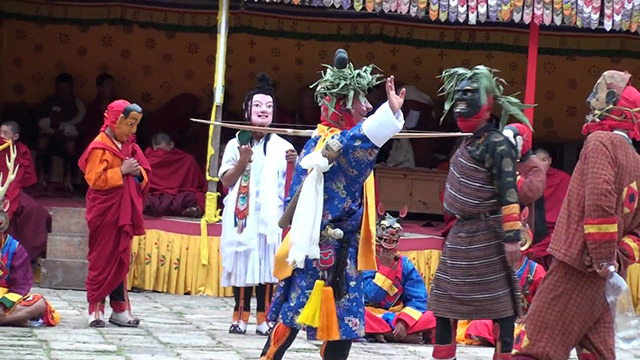 Gomphu Kora is a religious festival popular among the local tribes and Dakpa tribe of Arunachal Pradesh in India. Gomphu means Meditation Cave. As per the legends, this name came into life from a cave made of a rock face. Here a temple was also built, to pay tribute to this location.
Gomphu Kora is a religious festival popular among the local tribes and Dakpa tribe of Arunachal Pradesh in India. Gomphu means Meditation Cave. As per the legends, this name came into life from a cave made of a rock face. Here a temple was also built, to pay tribute to this location.
The festival comprises many local traditions and customs. According to the local's popular song, one should go around the cave today, or maybe tomorrow would be too late.
The festival is a symbol of the victory of good over evil. The place seems to come alive during the festive days, and the blessing is considered extremely pious, leading to thousands of devotees to travel here during that time.
During the festival, the entire area gets lively, and people flock to the site in the traditional finery to offer prayers to Guru Padmasambhava and seek his blessings. The trip around the cave is the major attraction of the festival.
Sakteng Tshechu, Sakteng
 Nestled at 3000m above sea level, the mesmerizing Sakteng Valley is home to one of Bhutan's most exciting festivals. The locals, called Brokpas, a semi-nomadic settlement, celebrate this festival to get blessings from their local deities. An occasion of festivity and fun, the alluring festival is an insight into the local culture.
Nestled at 3000m above sea level, the mesmerizing Sakteng Valley is home to one of Bhutan's most exciting festivals. The locals, called Brokpas, a semi-nomadic settlement, celebrate this festival to get blessings from their local deities. An occasion of festivity and fun, the alluring festival is an insight into the local culture.
Living close to nature in the pristine valley, Brokpas have remained untouched with modernization and have managed to preserve their centuries-old traditions and practices. During the festival, the entire community comes together to offer prayers and thank deities for the prosperity.
Like the other Tshechus celebrated in Bhutan, Sakteng Festival is marked by dance and local folk music. People dress up in traditional attires, and Ara (a local wine) is served, which is an integral part of the celebration. Two of the most famous dance forms performed in this festival are Rare Yak dance and Ache Lhamo, which are worth a watch.
Haa Summer Festival, Haa Valley
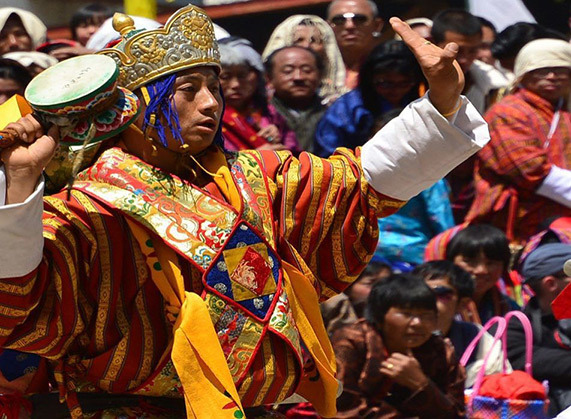 If you plan a visit to Bhutan during the summers, then the Haa Summer Festival in Haa Valley is a must-see. Demonstrating a blend of cultural extravaganza and nature's tranquillity, the festival celebrates Bhutan's nomadic and traditional lifestyles. The festival displays a vibrant local culture, perfectly complemented with the mouth watering local cuisine, religious performances, dance, songs, sports, and drinks.
If you plan a visit to Bhutan during the summers, then the Haa Summer Festival in Haa Valley is a must-see. Demonstrating a blend of cultural extravaganza and nature's tranquillity, the festival celebrates Bhutan's nomadic and traditional lifestyles. The festival displays a vibrant local culture, perfectly complemented with the mouth watering local cuisine, religious performances, dance, songs, sports, and drinks.
With the impeccable scenic landscape in the background, the Haa festival is the ideal chance to capture Bhutan's true essence and its scenic beauty at its best. This festival is also a paradise for photographers. There is also a contest for photography at the festival.
Masutake Mushroom Festival, Bumthang
 If you are a gastronome, the Masutake festival is the one you would want to visit during your trip to Bhutan. It is a cultural festival to spread knowledge about sustainable harvesting of the local mushrooms and promote organic harvesting. During the festival, the indigenous mushrooms and other organic food are exhibited. The Masutake Festival is a feast for every visitor.
If you are a gastronome, the Masutake festival is the one you would want to visit during your trip to Bhutan. It is a cultural festival to spread knowledge about sustainable harvesting of the local mushrooms and promote organic harvesting. During the festival, the indigenous mushrooms and other organic food are exhibited. The Masutake Festival is a feast for every visitor.
Bhutan Festival dates 2022
At Indo Asia Tours, the itinerary is not just a travel route or a trip. We design, conceptualise and handcraft every journey for you. Our special customised itineraries and curated experiences in different destinations are what make for those memorable travel moments.
|
Virtual Destination Training Program
|
 We can conduct a virtual destination awareness training program for your team or yourself or a virtual tour for your clients. Let us know the destination of your interest along with your convenient date / time and we will be happy to set up a program for you.
We can conduct a virtual destination awareness training program for your team or yourself or a virtual tour for your clients. Let us know the destination of your interest along with your convenient date / time and we will be happy to set up a program for you.
Send Request
|
Please feel free to write back to us at marketing@indoasiatours.com to share our thoughts on customized journeys covering the Indian subcontinent or take time to visit our website https://www.indoasia-tours.com. Be sure we will prepare the best program to make a memorable trip for your esteemed clients!
|
|


 Puna Drubchen is an annual festival started by Zhabdrung to celebrate the victory of the Bhutanese kingdom over the Tibetans. It is followed by the more famed Punakha Tsechu, introduced in 2005, keeping in line with Bhutan's Dzong and monastic traditions. The annual Drubchen or Dromche of Punakha is quite unique because of its dramatic recreation of a 17th-century battle scene. It is a beautiful narration of Tibetan invasion of Bhutan to seize the Ranjung Kharsapani, a self-created image of Chenrizing, Bhutan's most precious relic. The legends say that Zhabdrung planned an extravagant ceremony in which he allegedly pretended to throw the Ranjung Kharsapani into the Mochu River. When the Tibetan army saw the act, they got very disappointed and withdrew from the kingdom. During the festival, a procession of monks led by the head Abbott proceeds to the river, where he throws a handful of oranges symbolizing the relic.
Puna Drubchen is an annual festival started by Zhabdrung to celebrate the victory of the Bhutanese kingdom over the Tibetans. It is followed by the more famed Punakha Tsechu, introduced in 2005, keeping in line with Bhutan's Dzong and monastic traditions. The annual Drubchen or Dromche of Punakha is quite unique because of its dramatic recreation of a 17th-century battle scene. It is a beautiful narration of Tibetan invasion of Bhutan to seize the Ranjung Kharsapani, a self-created image of Chenrizing, Bhutan's most precious relic. The legends say that Zhabdrung planned an extravagant ceremony in which he allegedly pretended to throw the Ranjung Kharsapani into the Mochu River. When the Tibetan army saw the act, they got very disappointed and withdrew from the kingdom. During the festival, a procession of monks led by the head Abbott proceeds to the river, where he throws a handful of oranges symbolizing the relic. One of the most renowned and famous festivals of Bhutan is the Paro Tshechu, which is a Buddhist Festival. The festival holds great religious significance and is celebrated to remember Bhutan's patron saint Guru Padmasambhava’s birth anniversary. It was he who introduced Tantric Buddhism in Bhutan. The Paro Tshechu is held mainly in the huge and magnificent courtyards of the Dzong and comprises of some of the most colorful masked dances along with the traditional folk songs. What adds charm to this already vibrant festival is the colorfully dressed Bhutanese people who come here to rejoice in celebration. As per the Bhutanese calendar, which is a variant of the lunisolar Tibetan calendar, the Paro Festival falls during the Spring every year.
One of the most renowned and famous festivals of Bhutan is the Paro Tshechu, which is a Buddhist Festival. The festival holds great religious significance and is celebrated to remember Bhutan's patron saint Guru Padmasambhava’s birth anniversary. It was he who introduced Tantric Buddhism in Bhutan. The Paro Tshechu is held mainly in the huge and magnificent courtyards of the Dzong and comprises of some of the most colorful masked dances along with the traditional folk songs. What adds charm to this already vibrant festival is the colorfully dressed Bhutanese people who come here to rejoice in celebration. As per the Bhutanese calendar, which is a variant of the lunisolar Tibetan calendar, the Paro Festival falls during the Spring every year.
 Thimphu Tshechu is one of the biggest and most famous festivals in Bhutan. It is said that Tenzing Rabgye, the fourth Temporal Ruler established this festival in 1687, which was the 8th month of the Bhutanese calendar commemorating the birth of the Guru Rimpoche. It is organized in the courtyard of the Tashi Chhodzong, making it one of the most impressive Tshechus in the western region of Bhutan. The Tshechu is witnessed by thousands of people, the locals, and the tourists equally.
Thimphu Tshechu is one of the biggest and most famous festivals in Bhutan. It is said that Tenzing Rabgye, the fourth Temporal Ruler established this festival in 1687, which was the 8th month of the Bhutanese calendar commemorating the birth of the Guru Rimpoche. It is organized in the courtyard of the Tashi Chhodzong, making it one of the most impressive Tshechus in the western region of Bhutan. The Tshechu is witnessed by thousands of people, the locals, and the tourists equally.
 A must-see religious and cultural festival in Bumthang town, this festival is an exhibition of Bhutan's rich culture and heritage. This beautiful festival is celebrated for two reasons – one was the celebration of the deeds of Guru Rimpoche.
A must-see religious and cultural festival in Bumthang town, this festival is an exhibition of Bhutan's rich culture and heritage. This beautiful festival is celebrated for two reasons – one was the celebration of the deeds of Guru Rimpoche.
 Located on a forest-clad hill commanding the Phobjikha Valley, Gangtey Goemba is one of the oldest and most comprehensive Nyingmapa monasteries in Bhutan.
Located on a forest-clad hill commanding the Phobjikha Valley, Gangtey Goemba is one of the oldest and most comprehensive Nyingmapa monasteries in Bhutan.
 Gomphu Kora is a religious festival popular among the local tribes and Dakpa tribe of Arunachal Pradesh in India. Gomphu means Meditation Cave. As per the legends, this name came into life from a cave made of a rock face. Here a temple was also built, to pay tribute to this location.
Gomphu Kora is a religious festival popular among the local tribes and Dakpa tribe of Arunachal Pradesh in India. Gomphu means Meditation Cave. As per the legends, this name came into life from a cave made of a rock face. Here a temple was also built, to pay tribute to this location.
 Nestled at 3000m above sea level, the mesmerizing Sakteng Valley is home to one of Bhutan's most exciting festivals. The locals, called Brokpas, a semi-nomadic settlement, celebrate this festival to get blessings from their local deities. An occasion of festivity and fun, the alluring festival is an insight into the local culture.
Nestled at 3000m above sea level, the mesmerizing Sakteng Valley is home to one of Bhutan's most exciting festivals. The locals, called Brokpas, a semi-nomadic settlement, celebrate this festival to get blessings from their local deities. An occasion of festivity and fun, the alluring festival is an insight into the local culture.
 If you plan a visit to Bhutan during the summers, then the Haa Summer Festival in Haa Valley is a must-see. Demonstrating a blend of cultural extravaganza and nature's tranquillity, the festival celebrates Bhutan's nomadic and traditional lifestyles. The festival displays a vibrant local culture, perfectly complemented with the mouth watering local cuisine, religious performances, dance, songs, sports, and drinks.
If you plan a visit to Bhutan during the summers, then the Haa Summer Festival in Haa Valley is a must-see. Demonstrating a blend of cultural extravaganza and nature's tranquillity, the festival celebrates Bhutan's nomadic and traditional lifestyles. The festival displays a vibrant local culture, perfectly complemented with the mouth watering local cuisine, religious performances, dance, songs, sports, and drinks.
 If you are a gastronome, the Masutake festival is the one you would want to visit during your trip to Bhutan. It is a cultural festival to spread knowledge about sustainable harvesting of the local mushrooms and promote organic harvesting. During the festival, the indigenous mushrooms and other organic food are exhibited. The Masutake Festival is a feast for every visitor.
If you are a gastronome, the Masutake festival is the one you would want to visit during your trip to Bhutan. It is a cultural festival to spread knowledge about sustainable harvesting of the local mushrooms and promote organic harvesting. During the festival, the indigenous mushrooms and other organic food are exhibited. The Masutake Festival is a feast for every visitor.
 We can conduct a virtual destination awareness training program for your team or yourself or a virtual tour for your clients. Let us know the destination of your interest along with your convenient date / time and we will be happy to set up a program for you.
We can conduct a virtual destination awareness training program for your team or yourself or a virtual tour for your clients. Let us know the destination of your interest along with your convenient date / time and we will be happy to set up a program for you.


